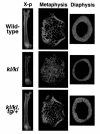Independent impairment of osteoblast and osteoclast differentiation in klotho mouse exhibiting low-turnover osteopenia
- PMID: 10430604
- PMCID: PMC408412
- DOI: 10.1172/JCI5705
Independent impairment of osteoblast and osteoclast differentiation in klotho mouse exhibiting low-turnover osteopenia
Abstract
We recently identified a new gene, klotho, which is involved in the suppression of multiple aging phenotypes. The mouse homozygous for a disruption of the klotho locus (kl/kl) exhibited multiple pathological conditions resembling human aging. Histomorphometric analysis revealed low-turnover osteopenia in kl/kl mice. The decrease in bone formation exceeded that of bone resorption, resulting in a net bone loss. The number of osteoblast progenitors determined by ex vivo bone marrow cultures was reduced in kl/kl mice. In addition, cultured osteoblastic cells derived from kl/kl mice showed lower alkaline phosphatase activity and matrix nodule formation than those from wild-type mice. Osteoclastogenesis in the coculture of marrow cells and osteoblastic cells was decreased only when marrow cells originated from kl/kl mice independently of the origin of osteoblastic cells. We also found that the expression of osteoprotegerin, an osteoclastogenesis inhibitor, was significantly upregulated in kl/kl mice. We conclude that a defect in the klotho gene expression causes the independent impairment of both osteoblast and osteoclast differentiation, leading to low-turnover osteopenia. Because this state represents a characteristic feature of senile osteoporosis in humans, kl/kl mice can be regarded as a useful model for investigating cellular and molecular mechanisms of age-related bone loss.
Figures





References
-
- Riggs BL, Melton LJ., III Involutional osteoporosis. N Engl J Med. 1986;314:1676–1686. - PubMed
-
- Manolagas SC, Jilka RL. Mechanisms of diseases: bone marrow, cytokines, and bone remodeling — emergency insights into the pathophysiology of osteoporosis. N Engl J Med. 1995;332:305–311. - PubMed
-
- Kuro-o M, et al. Mutation of the mouse klotho gene leads to a syndrome resembling aging. Nature. 1997;390:45–51. - PubMed
-
- Shiraki-Iida T, et al. Structure of the mouse klotho gene and its two transcripts encoding membrane and secreted protein. FEBS Lett. 1998;424:6–10. - PubMed
-
- Matsumura Y, et al. Identification of the human klotho gene and its two transcripts encoding membrane and secreted Klotho protein. Biochem Biophys Res Commun. 1998;242:626–630. - PubMed
Publication types
MeSH terms
Substances
LinkOut - more resources
Full Text Sources
Other Literature Sources
Molecular Biology Databases

